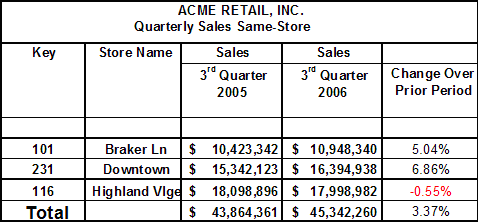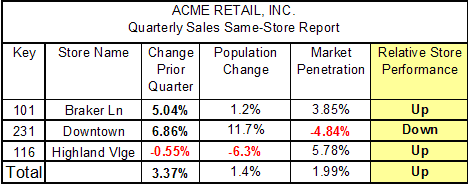|
|
What, No Comps?
In a surprise move in May 2006, home-improvement giant Home Depot stopped issuing comparable-store sales (or comps) numbers, becoming the first major retailer to withhold sales data for stores open at least one year, a closely watched measuring stick in the retail industry. While many analysts and investors quickly criticized Home Depot's move as a "bad decision," the discontent against comps has been building for a while. Revered by analysts, investors, and retailers for decades as a standard measure for assessing a retailer's performance, comps have been steadily facing criticism. While Home Depot may seem like an anomaly, both Wal-Mart's CEO H. Lee Scott and Sears Holdings Corp. Chairman Edward S. Lampert have also railed against comps (See Shopping Centers Today magazine, Note: 1 below). Wal-Mart complained because its strategy to supersaturate a market results in misleading same-store comps. Sears was unhappy because comps are not necessarily correlated to cash flow — a more important business measure. Home Depot's CFO Carol Tome explained that "same-store sales will become less relevant as Home Depot opens fewer stores and expands more aggressively into the wholesale-supply business."
What Comps Don't Tell YouWhatever the reason, it is clear that comps have come under fire. Their ability to accurately and legitimately measure a retailer's health from one month to the next is being questioned. Major problems arise not from what comps measure, but from what they can't measure — namely, overall sales of a retail corporation, customer loyalty at multiple locations, earnings, and a retailer's margins. Besides these cited shortcomings, comps also bear another less-obvious weakness: they don't discern fraudulent calculations. As a result, comps cannot comply with Sarbanes-Oxley guideline "to disclose to the public on a rapid and current basis such additional information concerning material changes in the financial condition or operations" (Note: 2 below). In fact, the financial reporting processes for comps are not precisely defined. Neither are they governed by SEC or GAAP, and are, therefore, easy to manipulate — giving retailers the creative urge to calculate comps to their advantage. One international retailer is reported to have employed 50 different processes for assessing comps in 65 countries. All this in a day and age where corporate performance is being watched more closely than ever before and former Enron executives are being judged by the jury for "willful blindness!"
Putting Demographic into the PictureThere is another fundamental problem with the way comps are reported. The two main factors that impact same-store comps are prices and the number of paying customers. The sales performance of a given store or group of stores is not absolute, but only relative to the population of the trading area-the geographic boundaries around the store that contain majority of the customers. The overall performance of the retailer is simply an aggregation of each comparable store's performance. Rising comps mean that either more people purchased products at the stores, or the customers paid more for the same things they bought a year ago, or both. Either way, sales increased without the added expense of opening new stores. This indicates that marketing is doing its job and the brand is popular with consumers. Prices are governed by the products' unique features, regional differences, advertising and promotions, and competition. The number of paying customers is mainly determined by the demographics for each store's trade area. Yet, today the same-store comps are reported solely over time by disregarding demographics altogether. When a store's performance is judged based on time element alone — without regard to the underlying demographic changes — it can present a distorted picture. As Peter Drucker said, "The basic assumption for our time must be that populations are inherently unstable and subject to sudden sharp changes-and that they are the first environmental factor that a decision maker, whether businessman or politician, analyzes and thinks through." For an investor or analyst, the traditional way of calculating comps provides insufficient information to make an informed decision. Without an understanding of the underlying demographic changes, there is no yardstick or benchmark to determine if the comps reported by the retailer are good or bad. It is impossible to tell how well a given store or a given retailer is performing unless it is benchmarked against changes in population. The following not-so-hypothetical scenario illustrates the problem:
Table 1: Traditional Comps

From this limited assessment, how can you tell which store is really performing well and which one isn't? Also, it fails to show if the retailer as a whole is keeping up with underlying demographic changes or not. It appears that the downtown store is performing the best based on a 6.86% increase over the prior period. But is this really true? A closer look at the underlying population changes during the same time period reveals the truth in Table 2:
Table 2: Enhanced Comps Overlaid with Demographics

The population increased by 11.7% in the trading area for the downtown store, but its sales increased by only 6.86%. In other words, its relative market penetration declined and hence its Relative Store Performance was down. The other two stores, however, increased their market penetration and actually performed better relative to the population changes in their respective trading areas. It's easy to see how the addition of population data both added a new level of internal control to the comps and also gave retailers a more sophisticated insight for making profit-focused business decisions. This double-duty from a single point of data is a significant advantage for analysts looking for the opportunity to simplify data research-including those who are tasked with overcoming the mounting challenges created by Sarbanes-Oxley's complex guidelines.
Holes in Their SOXThe Sarbanes-Oxley Act of 2002 was enacted to "protect investors by improving the accuracy and reliability of corporate disclosures made pursuant to the securities laws, and other purposes." Because looks can be deceiving, this type of analysis raises an important question: If the retailers do not report or track performance relative to population changes for external or internal management reporting purposes, are they in compliance with the letter and spirit of the Sarbanes-Oxley Act of 2002? Now that Home Depot has fired a shot across the bow, with other retailers likely contemplating their options, it is time to fundamentally reconsider the comps reporting:
About the AuthorsAbhay Padgaonkar (a management consultant, author, and speaker), is the founder and president of Innovative Solutions Consulting, LLC (www.innovativesolutions.org), which provides strategic advice to major clients such as American Express. Robert Welch is the President of Synergos Technologies (www.synergos-tech.com), which provides today's fastest-growing retailers with innovative geo-demographic tools including STI: PopStats™ — the market research industry's first quarterly population-estimating product. For more information, visit www.popstats.com Notes: 1. "To Comp or Not to Comp: Are same-store sales still a valid measurement of a retailer's health?," December 2005, by Joel Groover, Same Store Sales 2. "Sarbanes-Oxley Act of 2002, Section 409 (l) |
AnnouncementsA Migrating Population - Using IRS Data to Track Movement Patterns
The PopStats™ COVID-19 Impact Report:
|

